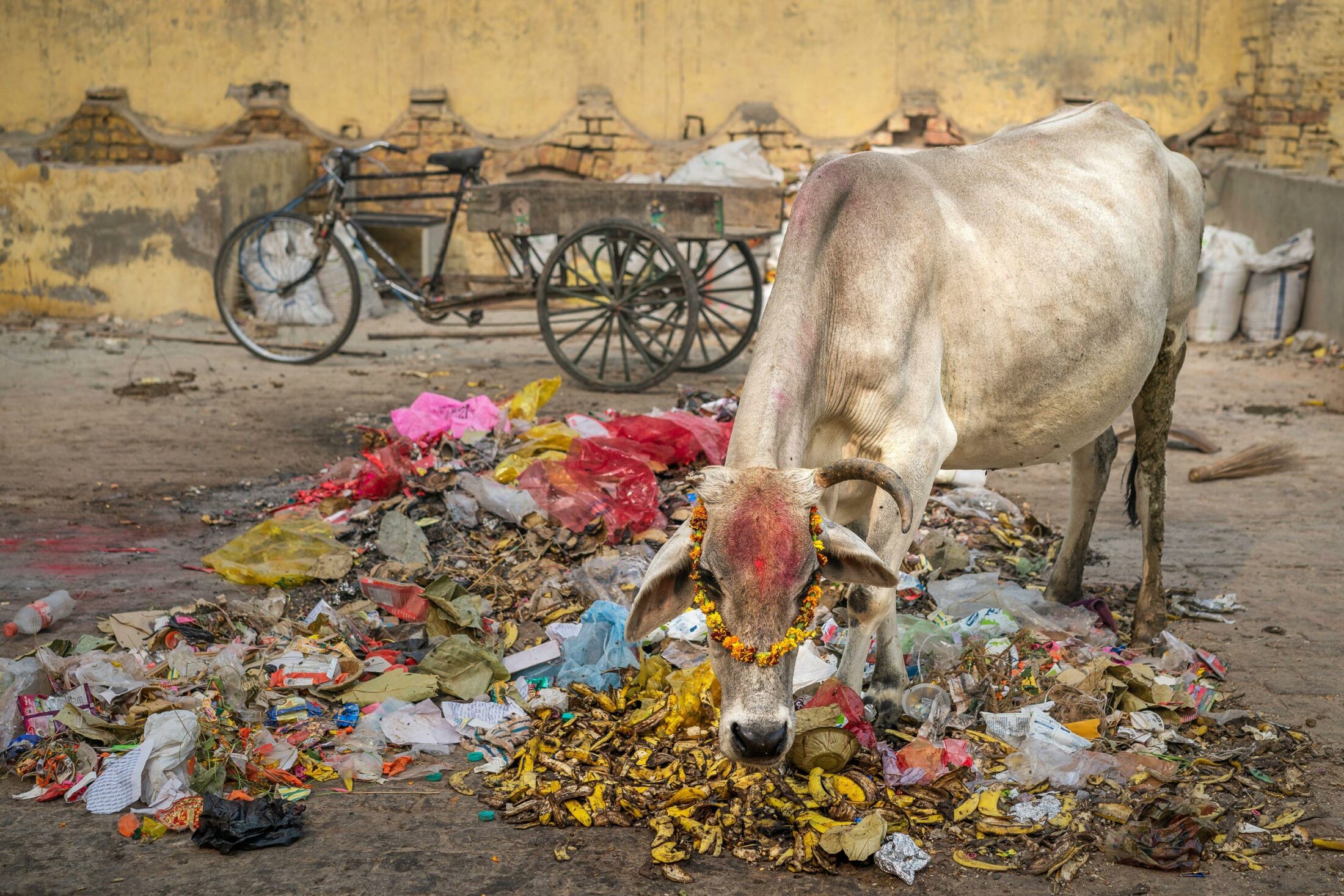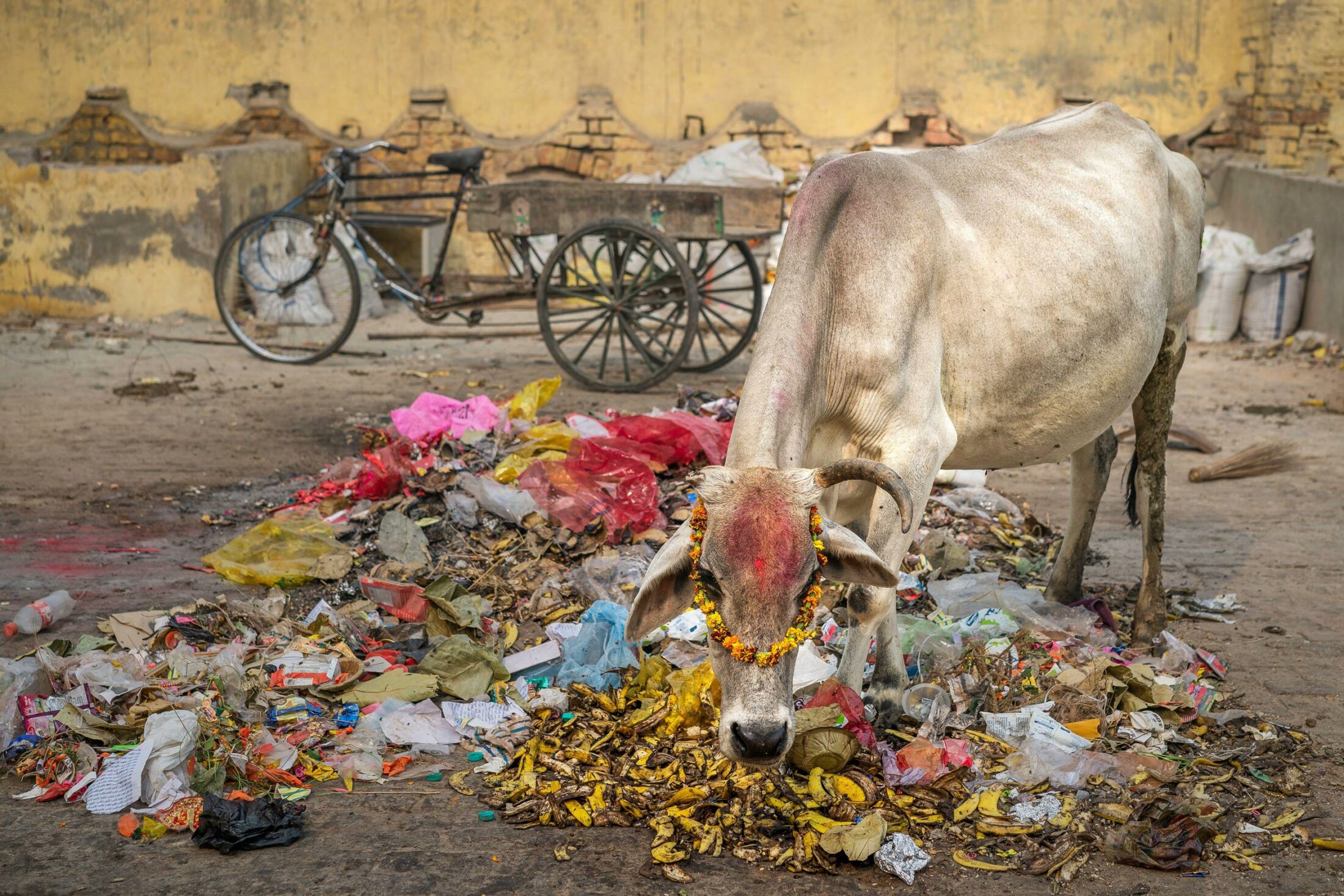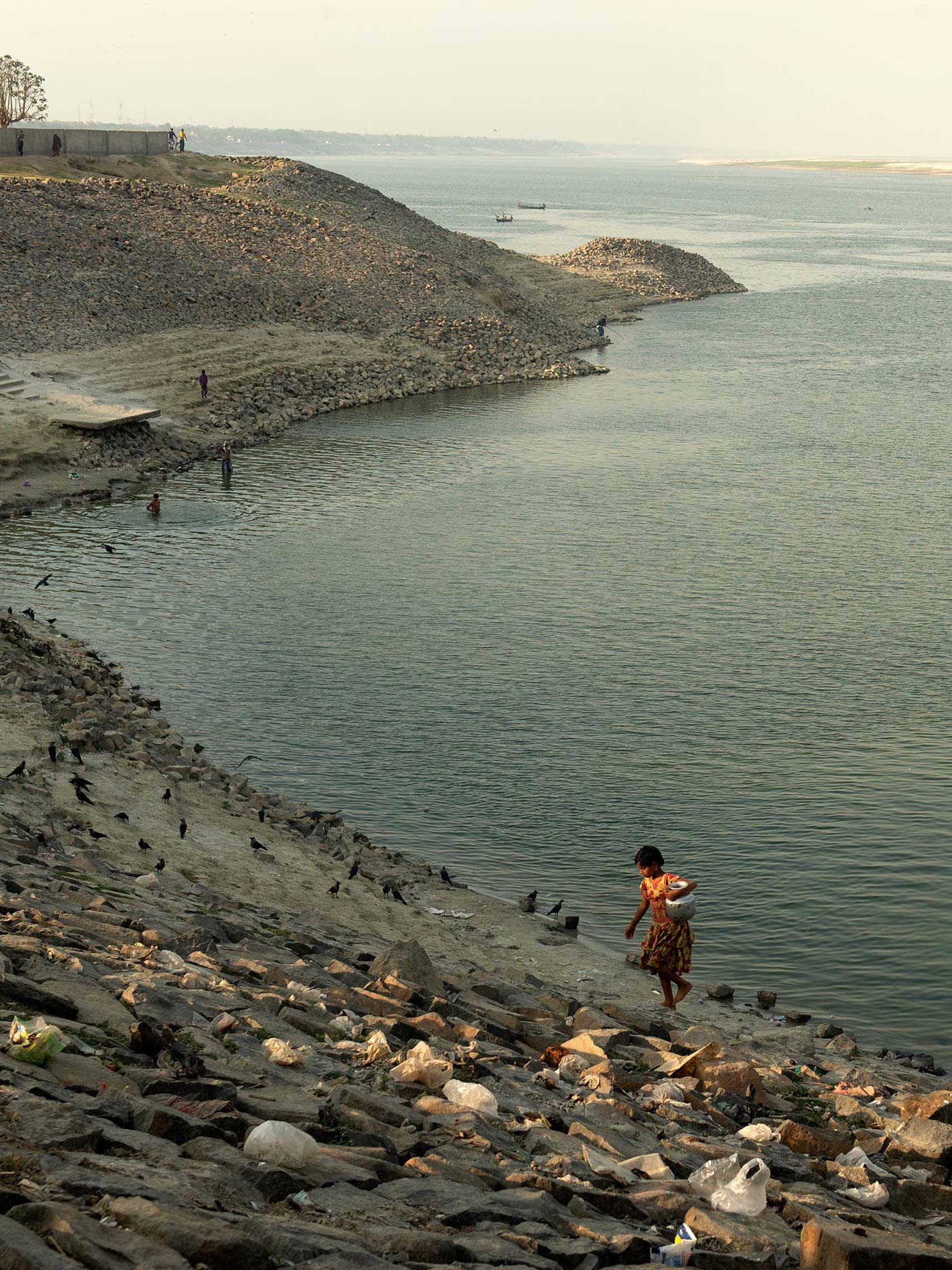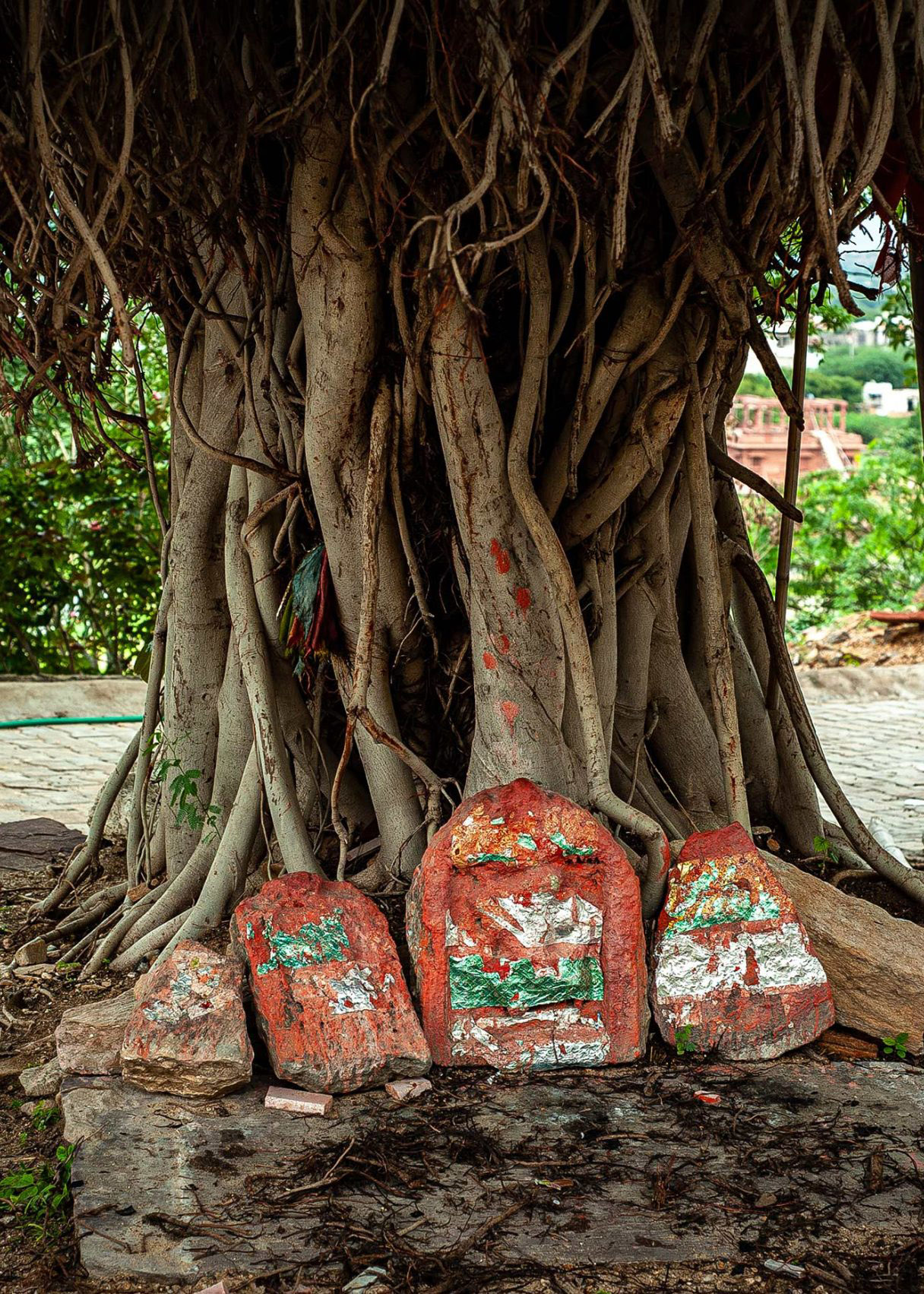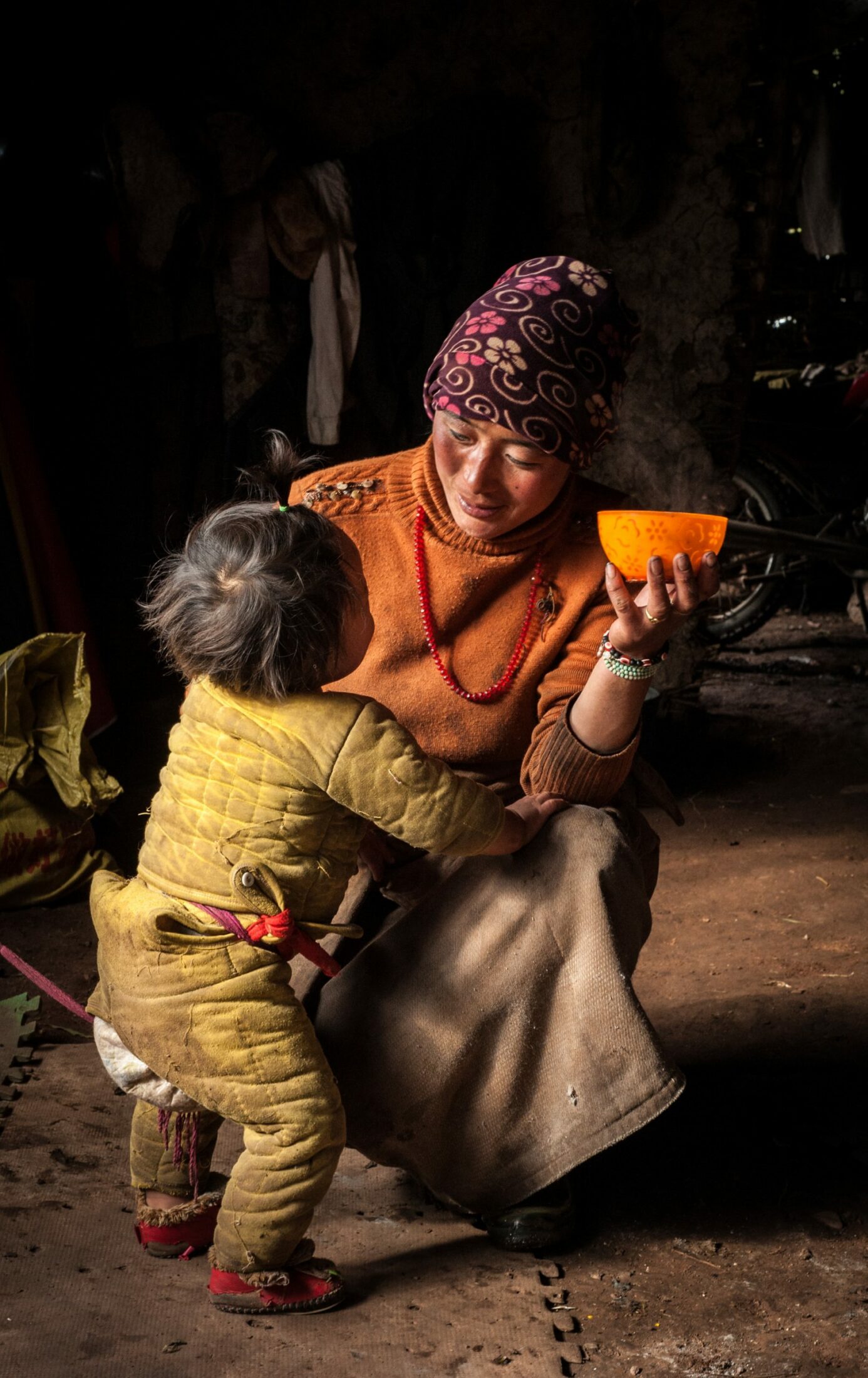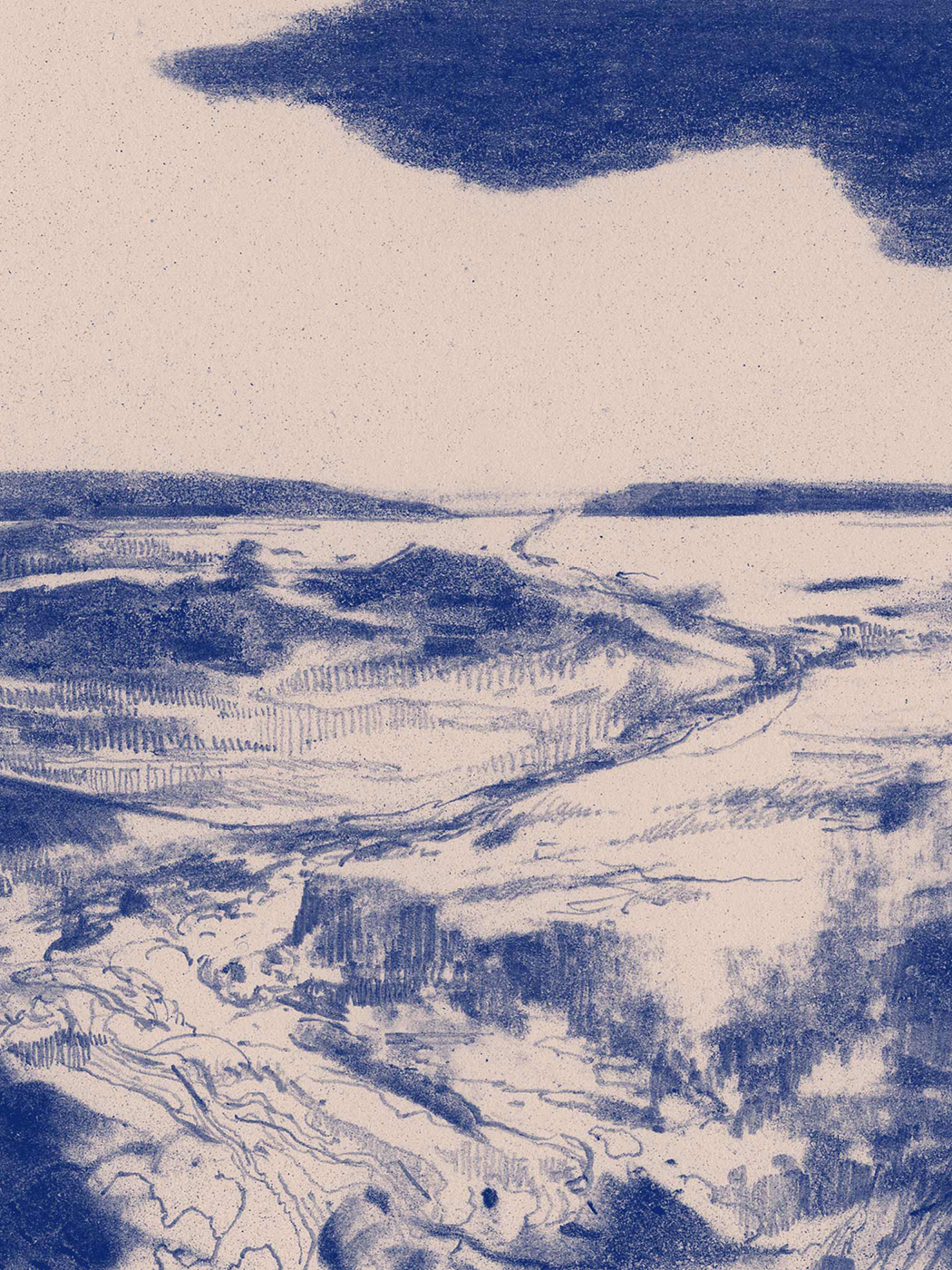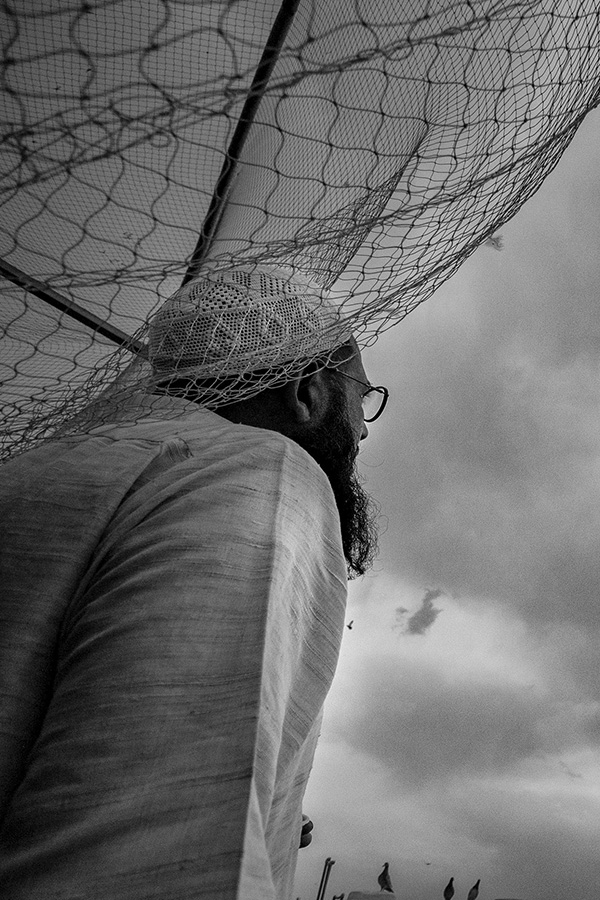
Lily Kelting is an assistant professor of Literary and Cultural Studies at Flame University in Pune, India. She is currently writing an academic book about the revival of heritage foods around the world, interweaving examples from the US South, Nordic region, and Western India. Sections of this research have been published in Food, Culture and Society, Southern Quarterly, and Paragrana. She is a former and occasional theater critic, magazine editor, radio journalist, dramaturg, freelance writer, and the mother of twins.
Savoring the complex flavor of milk from local cows who graze on trash and scraps, Lily Kelting considers what it means to taste the terroir of Pune, India, a city shaped by urbanization, pollution, and a colonial history.
Gauri is growing up fast. We met her when she was just two months old, her hair stuck to her body in swirls licked by her mother. She is a Holstein—a beauty—big wet eyes and wobbly knees and a strong, muscular neck. She lives in the apartment complex two doors down. She used to stay out in a parking space in front of the building, the rope around her neck chained to a metal loop welded to a sewer grate, but now she is in the back. The owners of the apartment building have created a cowshed from a small concrete storage area behind the building; the cowshed holds two lumbering buffalo, lights and fans for them, a water trough, huge plastic trays filled with shredded millet stems for them to eat. Just outside the shed stands Gauri; she is still barely visible from the street. The four-story apartment building above shields her from the rain. From a car, all you can see is a perfectly respectable twelve-unit apartment building, with laundry drying on balconies and carefully watered plants.
I can’t believe we’ve been in Baner for a year. In Pune, these under-construction exurbs on the edges of the city are called by euphemisms like “Baner Annex” or “Baner Next.” The road where Gauri and I live has no name—the landmark that the taxiwallas use to navigate is our own high-rise. We moved to the edge of the city because our twins needed more space: not in the American sense, but in the sense that two beds would not fit in any of our bedrooms. This new apartment complex has a playground: sold.
Now, I live up in the sky, up above the well-landscaped gulmohar trees of the housing societies clustered here at the foot of the tekdi, the green hill peeking between sky-high reinforced cement concrete towers topped by ever-glowing signs bearing the names of the real estate firms that built them. At night, the flash of welding from three construction sites across the way looks like sparklers. The construction continues even in the rainy season, when the flashes of sparks are confused for lightning. When I first moved to Pune in 2017, I felt such pity for those who lived in high-rise towers with cringey names like Pebbles. And now this is our home. A total alienated no-place, late-capitalist wasteland, cut across by a plastic-wrapper-clogged open sewer and nestled with small groups of temporary construction-worker housing made of corrugated tin and tarps. But even still: there’s Gauri.
Before this, we lived right in the middle of the city. The neighborhood is called Erandwane, which means castor forest, which is what the neighborhood was when my grandfather-in-law bought a small plot of land and built a small concrete house for his family. My father-in-law studied in a closet under the stairs. There are photos of my husband as a toddler feeding goats that nomadic herders would bring through. The road at that time was dirt. And then, almost exactly thirty years after he left, my husband moved back with an American wife—me—and then, when we had kids, the bungalow had hosted four generations.
Every day for a year, at 5 p.m., I loaded my twin toddlers into the car and headed for a small slum community about five minutes from the old house, just south of a local women’s college campus called SNDT. We went to feed the cows. The cows of Erandwane’s SNDT junction eat what they are given—leftover chapatis, blessed sweets given as prasad, the roots and stems left from sorting leafy vegetables. Across Pune, cows and goats graze on the city’s asphalt. These urban animals eat weeds. They eat trash. Their milk is delicious.
I say slum so that you understand, but technically it’s a gaothan. Gaothan means village in Marathi—like many Indian cities, Pune expanded around its village centers. These clusters of informal housing and informal markets are towered over by five-story middle-class developments and then towered over by high-rises in turn. The SNDT junction, named for the SNDT college on the north side of the intersection, stands right at the center of a much broader conversation about Indian urbanization. The larger neighborhood, Kothrud, was apparently included in the Guinness Book of World Records as the fastest urbanizing neighborhood in the world. This particular enclave—Pandurang Colony—is marked by a parade of diggers and dump trucks building new housing, a printing warehouse turned CrossFit studio turned performing arts venue, mobile food stalls serving cheap traditional breakfasts, a pearl shop, and a travel agency that’s always empty.
In this one lane, everything feels like a village: saris are draped to dry over handrails and motorcycles, a loose door is propped against a tree, chickens peck idly at grain, a dog scratches her ear, kids run around wearing collared shirts with no bottoms. Let’s not mince words about the urban gaothan: the residents are poor. These neighborhoods are traces of a smaller, preindustrialized city dwarfed by encroaching development. In Pune, gaothans are also the remnants of the city’s increasing industrialization. Many of the slum communities—especially the one I’m writing about—sprung up as workers’ housing around urban cottage factories. Pandurang Colony still produces boilers and sheet metal in workshops behind the narrow lanes. The Pune metro has come up on the road’s northern edge, and the corrugated tin buildings that stood there for years have been removed to make space for flat, white concrete slabs of sidewalk leading to a gleaming three-story escalator. Once these stalls are gone, it’s hard to even remember what was there before. Images of before return as questions. A flower seller with a basket of heaped marigolds in front of her crossed legs? The red, poured-concrete bus stop where I used to wait, each morning, for the bus? The area is changing, is “developing,” every day.
The gaothan provides the service economy for both the neighborhood’s hidden small-scale industry and the middle-class and rich inhabitants of the fancier societies that flank the slums. There’s a flour mill, a guy repairing rickshaws, a guy selling vegetables from a basket on the back of his bike. And there are goats, including one baby goat whose downy, translucent ears call out for touch. Chickens, yes. A tall cage of noisy brown doves. A scattering of birdseed on the ground. And cows.
Between two-story tenements, one large indoor cowshed, full of buffalo, anchors the block. Around twenty of them stand in rows, the geometric ridges of their hips lined up above their thighs. An aluminum wall stands hip high to separate the shed from the road, above which are visible the buffalos’ horns, heads of almost human hair. The air is thick with smoke—a twisted newspaper burns as bug repellent. Ineffective: the buffalo still swat idly at clouds of flies.
The second cowshed is open on three sides and in disrepair. Landfill and rubble from other buildings razed for the metro fill the northern corner of the lot. Here is where the bulls and calves required to keep the operation running are housed: it’s a reminder, as you enter the gaothan, that dairy is not just about the mother cow, Mother India. There is also the work of husbandry, the control of the cow’s reproduction and lactation. Passing the bulls and calves reminds me of what I used to forget—that milk comes from cows whose calves bleat hungrily nearby.
There is a Maharashtrian delicacy called kharvas. The first time I tried it, my husband refused to tell me what lent the steamed pudding its firm, bouncy texture in the absence of eggs. Flax? I mused. Agar? No: kharvas is made from colostrum, a word known most intimately to new mothers. Colostrum is the first fatty breastmilk that descends after birth to keep the infant alive in its first days of life, a nutritional miracle. Steamed with jaggery and cardamom, it is fantastic. I eat it when it is offered directly but cannot in good faith purchase kharvas myself.
The animals in this open shed are in bad shape. One of these bulls, the biggest, oldest one, has an embolism below its eye and looks at us with a purulent leer. There is often a small fire in the corner of this cowshed, burning trash. Where else should the trash go? This cowshed is the very edge of the edge of the neighborhood. As it burns, a small calf raises and lowers its head, out of idleness, of course, but as if nodding. The trash must be burned somewhere; no one wants the burning trash in their backyard. The bulls don’t seem to mind.
I download a joke app called “S**t! I Smoke” which takes my zip code and calculates how many cigarette equivalents of air pollutants I’ve breathed each day (nineteen). Everyone posts screenshots of the little cartoon cigarettes and then a day later we all realize it wasn’t that funny. When people ask me whether I plan to stay in India, whether I like living in India, tilting their eyes a little to the side and grimacing as if to suggest that this can’t possibly be where I will spend my one wild and precious life, I reassure them, “as long as the climate in Pune is still livable, I’ll live there.” Unbeknownst to us when we signed the rental agreement, our apartment in Baner Next looks out over a “recycling center” which bears the putrid smell of decaying trash on the summer breeze. The edge of the city: what were we thinking? But again, where else?
A little further up the road past SNDT are two more cows: Holsteins. The black and white spots are classic, storybook-like. I imagine the dreams the owner had for these cows. Roped to a metal link hammered into the asphalt, the Holsteins are especially pathetic. They occupy the four feet between oncoming traffic and the barbwire fence that marks the edge of the property. Their manure forms a crusted paste on the road.
One time, as the Holsteins ate our peelings from red buckets, a kid came from across the street to ask for money. We did not have any money, having only brought our trash. I was explaining, promising “next time,” when the kid’s father darted across the road, grabbed his son, dressed him down, and brought him back home. I rushed my own kids back to the car, not sure what to do. “Bye, cow!” they chirped, confused. They pronounce “cow” with a thick American accent, like me. We are often in but never of the gaothan.
Before Gauri, before Baner, we mainly fed one big, white, humped desi breed, one of three owned by a softspoken grandmother. Her eyes, like the cow’s, turn down at the corners. This cow wore a ring beaded with the Indian tricolor around her neck. My toddlers tossed our sorted greens into the bucket next to her chained neck, and laughed at the touch of her soft nose and rough tongue as she ate watermelon rinds from their hands. From this cow, they learned to nuzzle Gauri, who is just about their height. I think she recognizes them as children, like her. They grab the soft hair around barely protruding horns. And so now, whenever we are peeling carrots or sorting greens, they insist in their small, high voices: “let’s save these for Gauri, Mommy.” It touches me immensely that they are always thinking of her.
Can we talk about the taste of place when that place is an edge-place, a “developing” place, an ugly place, a no-place?
In Hindu mythology, one of the seven oceans of the primordial world, Kshira Sagara, was made of milk. The gods and demons churned this milk to butter in a great battle; from this came new life—including Surabhi, the primordial goddess mother-cow worshipped through her earthly avatars, cows. In the Satapatha Brahmana, milk is the sperm of Agni, the god of fire. Milk is elemental, powerful, flowing freely from the prehistorical past into our waiting thirsty mouths.
Because milk is theologically purifying, it is used to sanctify icons of gods and goddesses, to do abhishek. I once visited one of the twelve famous Jyotirlinga, a phallic embodiment of the god Shiva. So much milk was poured over the basalt phallus that coming to gaze on the god required walking barefoot through a thin slick of milk, stained with red and yellow swirls of haldi kumkum, flotsam marigold petals, and stray tinsel.
Once every twelve years, at the Mahamastakabhishek at Shravanabelagola, a thousand liters of milk are poured over the towering sculpture of the Jain saint Bahubali. The milk streams over his perpetually open eyes, into the cavity of his chest, over his belly. The milk forms, suggestively, a white waterfall over the sculpture’s nude phallus and across his thighs. A white lake pools at the Bahubali’s feet—“bili-kola”—from which the town Belagaola itself gets its name. During this time, for the many visitors as well as the monumental abhishek, the Hassan Milk Producers Union trucks in eight thousand liters of milk a day. Reading these statistics on my phone after watching the smaller, daily abhishek, I imagine the line of milk tankers waiting ready on the small access road. I think about people who are starving, for whom these liters of milk might mean very real salvation. I think about our old dudhwalla, the milkman who came each morning, huge panniers filled with milk bags on his motorcycle, and announced himself with a chesty “dudh!” I think about the rising cost of milk and wonder whether it will go higher. I don’t know what to think about any of this.
A lot has been written about milk’s theological and symbolic power in an Indian context. Very little has been written about how it tastes. Some people buy packaged milk from brands like Amul. These pan-Indian milks taste, predictably, like TetraPak. I keep one in my office in case of emergency (the emergency is that I have to teach and need a coffee). But most people—certainly most Punekars—are buying milk from small dairies like the one at the SNDT gaothan, urban and peri-urban dairies that function amid the life of the city, not outside of it. Back in the family house in Erandwane, the milk has come from the same small dairy’s family for the past three generations. Their dairy, out in Pune’s other exurbs, is bigger than the one at the SNDT junction: they have about fifty buffalo. In winter, the milk comes late because the milkman must give each buffalo a little massage to warm her before milking. This buffalo milk is arresting, a mouthful, rich and deep like cheese.
I am always eating my way into place, always at the market squeezing one plum or another. Part of this interest is professional—I teach food studies—but mostly it is just my desire to immerse myself, as much as possible, wherever I am. While terroir, the original French concept, is perhaps outré, its literal meaning, “taste of place,” is a useful and generative idea. Use of the term is booming alongside more explicit concerns with local eating and “farm-to-fork” dining. But I am compelled to wonder (because I am, by both scholarly training and disposition, critical; because I live next to an open sewer): What places does the concept of “taste of place” exclude? Is there room enough here for the milk I boil for my sons each morning, holding the raft of cream back from the lip of the tall steel boiling jar with a fork, keeping that cream aside to make the day’s yogurt? Can we talk about the taste of place when that place is an edge-place, a “developing” place, an ugly place, a no-place? Is there room within the concept of terroir, I guess I am asking, for me?
Even among experts—winemakers and cheesemakers—it can be difficult to understand what people are talking about when they say “taste of place.” What about tradition? What about bacteria? In wine making, terroir comes down to soil composition, elevation, slope, sun, rainfall, and other microclimatic factors that give the wine a certain taste. A French Cabernet Sauvignon will have a stronger, more acidic, more mineral edge—it will have more terroir—than one produced in California. Although, of course, the slate from the soil can’t come up through the vines and into the grapes and into the glass: it’s simply physically impossible. So what are we really tasting here? I was at a terroir roundtable one time and watched a bunch of cheese people shoot down a lone naysayer who asked this question. He has a bad palate, they insisted. Maybe he just needed to try more cheese? Maybe he just needed to have someone explain it to him the first time, so he could see for himself thereafter? “You can taste the difference, you can,” they intoned. One cheesemaker pleaded, “please let me send you some cheese.”
Terroir is a kind of religion, a structure of feeling. No one wants to send the milk to a lab and find out its terroir. That is not the paradigm. Terroir is about a kind of holiness, a union between food and environment almost spiritual. In that sense, milk is the perfect vehicle for terroir, because the vehicle is not the inert grape, but the living, breathing, eating cow. We feed her and she feeds us. The scale of the Indian dairy is so small that there is no place to hide; the milk tastes like what the cows ate. Cows are routinely fed the stalks of sorghum and millet—agricultural byproducts left behind after producing the millet flours that are staple grains in Maharashtra. Feeding the otherwise inedible stalks to cows reduces waste: essential when the profit margins for agricultural workers are already so tight. The economy of the urban dairy has no choice but to be circular. Sugarcane is the real cash crop of this region. Juiced sugarcane stalks seem to be nothing but tough fibers, but still they are chipped into small pieces and fed to cows. Of course the milk tastes sweet.
Articulating a concept of “local foods” that accounts for non-pastoral, non-idyllic local is also, for me, about sacralizing these urban landscapes. It is almost impossible to think of the milk produced by the slum cows of India as having terroir, which is why it is essential to do so—to expand our definition of “foods that taste of place” to milk that tastes of roadsides, of leftovers, of rotting marigolds, stems and packaged biscuits and the rinds of old fruit. I’m trying to focus not just on what is being lost, but on what is being created in these spaces. These are not no-places; they are terroir. We can taste these places: through the milk of urban dairies, we do. It’s easy to look at the SNDT junction cows being edged out by gentrification and see progress. It is harder to look at the urban gaothan as a generative space, as a fertile space, a space that feeds.
That phrase, “sacralize urban landscapes”? What does that actually mean? I think I mean: To live here. To make a home in a high-rise by the side of the highway. Not to grow roots, but to hold the roots firmly in one hand, cut them free, shake off the dirt, and bring them to Gauri.
Urban cows out to pasture in Pune eat not only leftovers, but the invasive, omnipresent Congress weed, Euphorbia hirta dotted with small white flowers, the wild amaranth and Malabar spinach that green the city’s vacant lots each monsoon. These cows are not eating grass—North America’s most typical idea of a healthy and happy cow’s diet. They are eating everything. It’s easy to forget how diverse, how robust, the ecology of India’s cities is. The cows are eating dropped wild figs and tamarind and sour gooseberries blown off their trees by storms. The city’s abandoned corners—the highway verges and street sides that count as pasture here—are full of food.
In the West, this quest for increasingly specific microterroirs is at a fever pitch. Stone Barns / Blue Hill chef Dan Barber made a career out of terroir, even plating up the “single-udder butter” of their “star milker,” Elsie, for special guests to the farm-restaurant as its own special course. “Single-udder butter” was later revealed to be more or less a hoax: or rather, a dream, an idea, a poetic gesture. The commodification of “single-udder butter” for food world VIPs proved unsustainable, even fatuous. Sweet Elsie could simply not give enough milk. But the gesture towards a more creative definition of dairy terroir persists; ever since first hearing the term, “single-udder butter” has stuck in my head. “The poor are stuck with the tyranny of the local,” chastises food historian Rachel Laudan. Poor people in India are drinking single-udder milk all the time. But no one cares, which is why I am telling you about it. If this is not terroir, we have no terroir at all.
I pour myself a steel tumbler of milk and try to describe what it tastes like. It’s heavy and stratified, like the geological layers of the earth? Somehow softened, round, gently cooked. It’s rich and kind of musky? How is this vegetarian? It tastes of buffalo. My mouth is full of fat. Its richness is all over everything—the walls of my cheeks, my tongue. I have now drunk three glasses of milk. I can’t describe it. I’ll get another.
Terroir is about a kind of holiness, a union between food and environment almost spiritual. In that sense, milk is the perfect vehicle for terroir, because the vehicle is not the inert grape, but the living, breathing, eating cow. We feed her and she feeds us.
What is there to say about the Indian cow that isn’t already overexpressed in both the Indian and Western cultural imaginaries? “The central fact of Hinduism is cow protection,” wrote Mahatma Gandhi in 1921 in Young India. This abstract assertion is now actively enforced through the steady political work of institutions like the right-wing, paramilitary Hindu nationalist organization, the RSS, and the current governing party of India, the BJP. The BJP’s cow protection policies have empowered vigilante mobs to police “beef-ban” legislation; these mobs attack anyone even suspected of “smuggling cattle” to sell as meat. The accused are always, as you might expect, Muslim or Dalit: the groups who, due to ideas about pollution rooted in religious and caste bias, work most closely with animals’ bodies. Some of these victims, like Rakbar Khan, murdered by cow protection vigilantes in 2018, are themselves dairy farmers. The threat of violence floats like an aura over each holy cow. Meanwhile, buffalo abattoirs are busier than they have ever been.
While the milk-producing cow is seen as a mother figure in India, the aging cow is waste. Cows are expensive to feed and maintain—if a cow is no longer able to give milk, and unable to be sold for meat or leather, what should be her fate? Unproductive cows are released by cash-strapped agriculturalists to roam the streets. It is hard to explain the magnitude of India’s stray cow problem to Westerners. We simply live within these contradictions. In the 2019/20 year, over thirty-eight thousand stray cows were killed by passing trains across India.
In Baner, I pass two small herds of stray cattle each day on my commute home from work. One merry band moves slowly down a grassy highway verge to a recycling center littered with dry trash and back each day. One brown cow mainly lays diagonally across two lanes of traffic, blocking the entire highway underpass. Angry drivers honk their horns at her, but I wait. This road is, after all, her home.
Gauri and the SNDT cows occupy a middle category within this bovine landscape. They are not housed in a gaoshala, the cattle sanctuaries created by cow-protectionists. Neither are they strays—for the community, the SNDT cows are the single greatest asset besides their own laboring bodies. The dairy buffalo are not industrialized, but it’s a bigger operation than a single cow. I have become obsessed with these cows’ neither-here-nor-thereness. They are not exactly in the way, not exactly out of the way. They occupy space that would otherwise by occupied by litter. Many populous Indian megacities have pushed out the urban dairy—Delhi, for example, has restricted the urban zones in which small-scale dairies can operate, although many still do, illegally. For the time being at least, the Baner Next and SNDT Junction cows remain.
The fact that Hindus have a religious obligation to feed cows means a steady stream of visitors to the gaothan. Ajis in neat, printed Punjabi suits tell their rickshaw driver to wait a minute while they hand a cow a neatly folded chapati. Our neighbors come with a small yellow plastic bag of food scraps. Occasionally, another family with another son. A businessman steps out of a Mercedes with shiny shoes and takes the cows’ blessing, reverently touching the cow’s strong neck and then his own forehead.
A friend told me a story about an entrepreneurial farmer who stationed his cows outside a bustling temple—the worshippers, mostly from the milk-state of Gujarat, are compelled by religious convention to feed his cows for him. A second hustler sells grass bundles. The farmer’s cows are fed so full of grass that they turn their heads away.
“The cow is a poem of pity,” Gandhi continues in his essay. Most of the associations with cows eating trash are really cows consuming plastic. Indian cows do consume so much plastic it’s almost unthinkable—various newspaper articles, YouTube videos, and What’s App forwards chronicle the removal of 18 kg of plastic waste from a cow’s rumen, 27 kg of plastic, an impossible-sounding 52 kg. “It is normal to remove plastic from cows,” one doctor reported to the interviewer, “this is not new.” Cows—often stray cows—pick at unsegregated roadside waste in an attempt to get at leftover food inside plastic bags and foil wrappers. Indeed, this seems to be the full-time pastime of the stray cows that drift around the recycling center on the Mumbai-Pune highway access road. Their soft lips mouth across yellow plastic carry bags, blue plastic carry bags, pink carry bags meant to resemble fabric but which are, again, ultimately plastic. One study even explored whether cows are singularly attracted to the smell of decomposing plastic compounds, because cows consume so much plastic. I suspect, although this is wholly unscientific, that they are just hungry.
When we feed the SNDT junction cows, their owners ask us each time—“Just greens, right? Just food, right? Not the newspaper, please. No twine. No twist ties.” To call a vet could bring financial ruin. The cows do not leave their chains for a very good reason: what if they eat a plastic bag? Instead the cows consume so much other waste—sugarcane stalks, agricultural byproducts, old chapatis, and flowers. The contents of their rumens and the taste of their milk is a direct index of the human life teeming around them. If they eat plastic, the milk is toxic. If they eat the juiced-up husks of sugarcane stems, the milk carries an almost inappropriate sweetness. If they eat old chapatis and scraped-up dal bhat and who knows what else, the taste is—I can’t describe it. Only maybe this: it carries the scent of so much other human excess. Our cabbage leaves and green onion roots go to the smaller cows who are not yet lactating. Coriander roots will not show in the milk: they can be fed to the heifer.
How can I make sense of this milk made in slums? How can I make sense of these animals living, sleeping, lactating on the side of the road where, in a different city, the sidewalk would be? If I think of the SNDT junction as being an actual place, then what is the taste of that place? What does it mean not only to look at these overlooked spaces, as pornographic images of India’s poor often do, but to taste them? What does “the local” mean in Baner Next, a skyline of pollution, mud, and already-fading gloss?
Pollution is colonialism, writes Max Liboiron. It is a disruption to “land-body relations.” What does this mean in an Indian context, where the whole neighborhood is a dumping ground? This omnipresence of trash on roadsides, in cows’ rumens, tells a clear story about what it means to live in the Global South. Living with trash is the condition of being postcolonial. None of this is abstract. This is about the taste of milk. I want to talk about this milk, which you have never tasted. I want to talk about this milk, which arrives in a plastic bag I can’t recycle. I want to talk about this milk, which is so local that it tastes of all that we leave behind.
“The cities of the future,” writes Mike Davis, “are largely constructed out of crude brick, straw, recycled plastic, cement blocks and scrap wood. Instead of cities of light soaring toward heaven, much of the twenty-first century urban world squats in squalor.” There is no romanticizing “the outside” in the context of the slum, where even homes are open to the wind. The urban gaothan, not the rural gaon, is our future. When all these buildings are no longer under construction but finished, parceled into units, and sold; when Baner Next is full and is called simply “Baner”; when even the four-story building with the cowshed is razed to become another high-rise—there will be another Baner Next, and another after that.
And yet! There will be cows. There will be milk. The milk will taste like us, like home.
